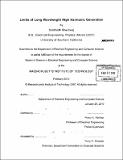Limits of long wavelength High Harmonic Generation
Author(s)
Bhardwaj, Siddharth
DownloadFull printable version (10.67Mb)
Other Contributors
Massachusetts Institute of Technology. Dept. of Electrical Engineering and Computer Science.
Advisor
Franz X. Kartner.
Terms of use
Metadata
Show full item recordAbstract
Many researchers are pushing for long wavelength driver pulses for High Harmonic Generation (HHG). The advantage of longer wavelengths is that the cut-off of the harmonic spectrum can be increased without the need for large electric fields. Large electric field is undesirable because it leads to large plasma generation which reduces harmonic generation due to phase mismatch and ground state depletion. Most of the current literature on HHG uses the Dipole Approximation for calculation of harmonic spectrum. The physical ramification of the Dipole Approximation is that it neglects the magnetic field component to the driver field. It is well known that a charge moving in a magnetic field experiences a Lorentz force. In HHG, harmonics are generated by recombination of an electron wave packet, moving under the influence of the driver pulse, with its parent atom. The Lorentz force can displace the electron wave packet perpendicular to the direction of polarization and as a result reducing the recombination amplitude. This Lorentz displacement increases as we move towards longer wavelengths and higher intensities. In this thesis, intensity and wavelength limits at which the Lorentz displacement becomes significant have been investigated. By numerically solving the time-dependent Schrödinger equation, we investigate the optimum driver pulse duration for 400 nm, 800 nm and 2 micron driver pulses for a given harmonic for hydrogen. (cont.) It was found that longer wavelength have smaller efficiencies (neglecting phase matching condition). Finally, the harmonic spectrum of Hydrogen driven by 800 nm pulse predicted by analytic Three Step Model (TSM) has been compared with the harmonic spectrum generated by numerical solution of time-dependent Schrödinger equation. It was found, as the current theories predict, that TSM becomes less reliable as the Keldysh Parameter increases. It was also observed that for low harmonic energies, the TSM spectrum deviates from the numerical spectrum by many orders of magnitude.
Description
Thesis (S.M.)--Massachusetts Institute of Technology, Dept. of Electrical Engineering and Computer Science, 2010. Cataloged from PDF version of thesis. Includes bibliographical references (p. [75]-76).
Date issued
2010Department
Massachusetts Institute of Technology. Department of Electrical Engineering and Computer SciencePublisher
Massachusetts Institute of Technology
Keywords
Electrical Engineering and Computer Science.